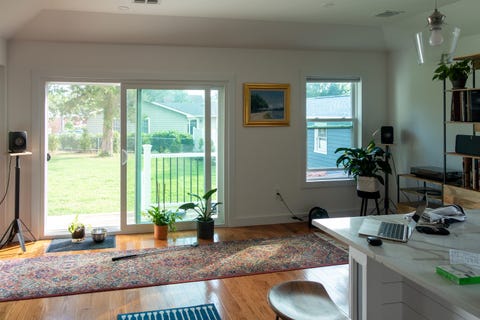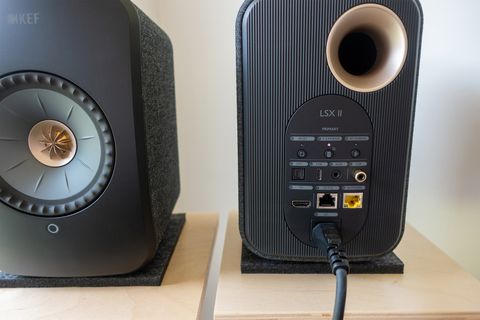The KEF LSX were already one of our favorite active speaker systems — we called them the “perfect hi-fi all-in-one speaker system” when we originally reviewed them back in 2018. They were essentially a smaller and more affordable version of KEF’s super high-end and super versatile LS50 Wireless speakers. Well, it’s been a few years and KEF has now released a second generation version: the KEF LSX II.
The LSX II don’t look much different from the original LSX — in fact, other than a few slightly changed colored finishes, they are virtually identical — but KEF has given these “Gen 2” active speakers quite a few upgrades under the hood. The new models sound sound better, are more versatile and are even easier to use. The downside? Well, they’re also a touch more expensive.
The KEF LSX II is available in five different finishes: carbon black (shown), blue, lava red, mineral white, and a soft gold (called “soundwave”).
What’s Good with the KEF LSX II?
The LSX II make listening to great sound easy.
The KEF LSX II is a wireless music system consisting of two bookshelf-sized powered speakers. Each speaker is individually amplified and powered, and they also talk to each other wirelessly; this means that you don’t need a wire connecting the left and right channels. You just place the speakers as close or as far apart from each other and they’ll just work; this makes them great for both small or large rooms, as you don’t have to worry about tripping over or hiding a wire.
Listening to music on the LSX II is extremely easy. The system supports a multiple of wireless (Bluetooth and Wi-Fi) and wired connections. You can easily stream music straight from your smartphone via the likes of Bluetooth or Spotify Connect. You can even integrate the LSX II into a multi-room sound system via AirPlay 2 or Chromecast. Or you can also hardware the speakers directly into a music source like a CD player or a computer. You’ve got options.
A super soundbar alternative.
It seems like more and more wireless speaker systems are adopting an HDMI-ARC connection — and the LSX II is no exception. Unlike its predecessor, the LSX II have an all-new HDMI-ARC port that allows you to connect them directly to your TV and they’ll work just like a modern plug-and-play soundbar. There’s no AV receiver or any other extra components required. It just works.
When connected to your TV via HDMI-ARC, the LSX II supports lossless CD-quality audio (up to 16-bit/48kHz). There’s no lag issues with dialogue. And the fact that there’s dedicated right- and left-channel speakers, helps the LSX II deliver a wider soundstage than even high-end soundbars can deliver. There’s no support for Dolby Atmos, unfortunately, which is a bit of a bummer for home theater buffs.
A better desktop audio situation.
KEF has given the LSX II a new USB-C port on its rear and this was designed to make them work as even better computer speakers. You had to use AUX port on the original LSX speakers (and you can still do this on the LSX II) to do this same thing and, admittedly, both solutions are still able to play lossless audio (up to 24-bit/96kHz). The difference is that the USB-C connection allows for a more straightforward path to the LSX’s on-board digital-to-analog converter (DAC), which is likely much better than your computer’s on-board DAC, and therefore you’re going to get a little bit cleaner sound. (Albeit, you might have to be an audiophile to hear the difference.)
The other advantage is that, if you’re feeling cheeky, you can use this USB-C port as a charging port. All you have to do is go into the KEF Connect app and switch it into a power delivery mode — it’s called KW-1 power mode in the app. From there, you can use it to charge your various other devices like your smartphone or tablet. I’m not sure you’d need to do this in a desktop audio situation as you’ll likely have other charging options that these fancy speakers, but it’s an option nonetheless.
A superior wireless streaming machine
KEF didn’t completely rewrite the script with the LSX II. The speakers are the same size as the original LSX and they utilize the same Uni-Q driver; this is KEF’s signature driver that places the tweeter in the center of the midrange/woofer and that the company claims helps deliver a more lucid and room-filling sound. (KEF uses this same driver in its larger speakers, including LS50 Wireless II, LS50 Meta and LS60 Wireless.) KEF says it did tweak the digital-signal-processing (DSP) of the new speakers so they’re more well-balanced and sound even better.
The other difference is that KEF has given the LSX II access to its new “W2” wireless streaming platform (just like its newest LS50 Wireless II). Effectively, it makes it really easy to play the music you want (via streaming or analog) as well as customize the sound of the speakers for your and your room. It’s all done through the KEF Connect app on your smartphone and it makes the speakers really easy to use.
What’s Not Ideal with the KEF LSX II?
You still need a wired connection for the best possible sound
Just like KEF’s other wireless speaker systems, the LSX II can play lossless audio without each speaker being tethered to one another — and it sounds great. When streaming over Wi-Fi, the LSX II can play lossless audio that’s up to 24-bit/48kHz. However, if you use the included cable that tethers the two speakers together, they can play even higher-resolution audio that’s up 24-bit/96kHz. This isn’t a bad thing at all, but it’s worth noting for lossless streamers looking for the best possible audio quality out of the LSX II.
(The downside to having a cable it’s not as clean and you can’t as easily place the speakers anywhere you want in a room.)
Do you really need all these options?
Too much versatility isn’t a bad thing, especially when the KEF LSX II excel in pretty much everything they do. The issue is that most people aren’t going to take advantage of all this versatility — they’re going to set the LSX II speakers up and likely use them one way. For me, I have been using them basically like badass Sonos speakers and just streaming music from my smartphone and laptop. And so ultimately you’re paying for features and abilities you’re probably not going to use. KEF has increased the price of the KEF LSX II, which cost $1,400 per pair while the LSX were priced at $1,100 per pair when they were released in 2018.
KEF LSX II: The Verdict
The KEF LSX II is a wonderful little hi-fi speaker system that can basically do anything that you want. You can stream music to them via Wi-Fi or Bluetooth. You can even integrate them into a multi-room system with non-KEF speakers via AirPlay 2 or Chromecast. Or you can hook them up to your current hi-fi system, desktop workstation or even your TV. And it all sounds supreme. The only real downside is that, well, it ain’t cheap.
This content is created and maintained by a third party, and imported onto this page to help users provide their email addresses. You may be able to find more information about this and similar content at piano.io










